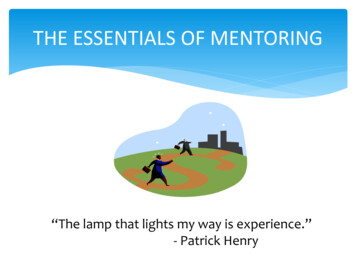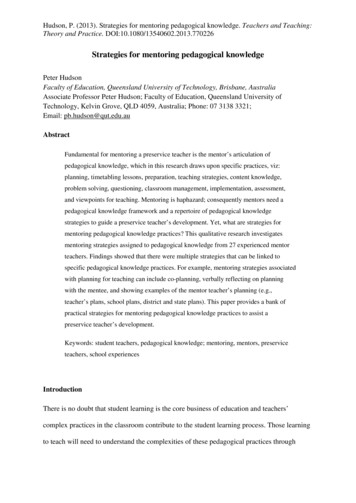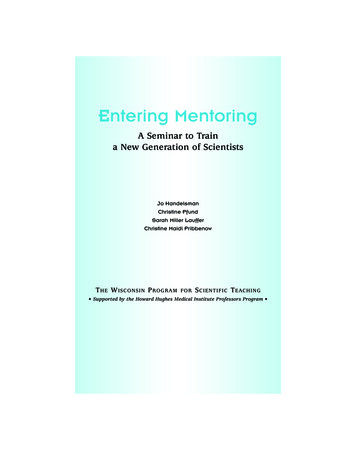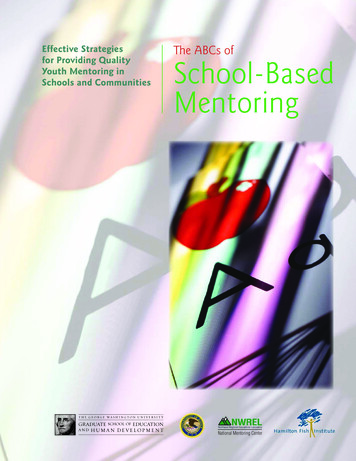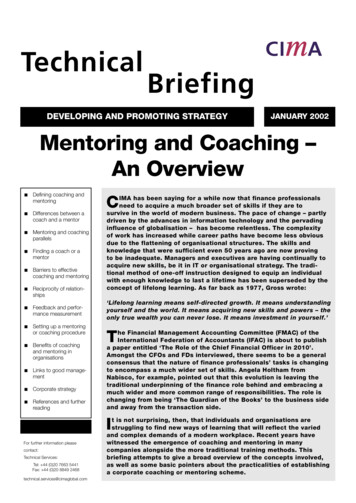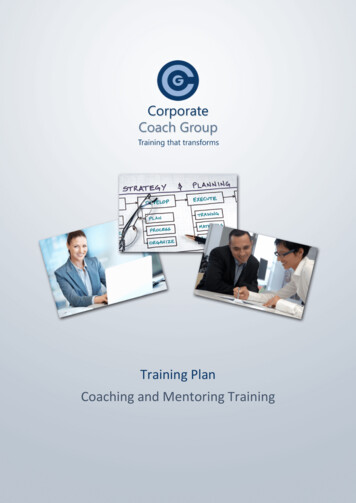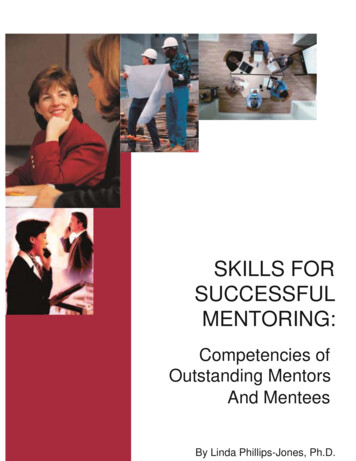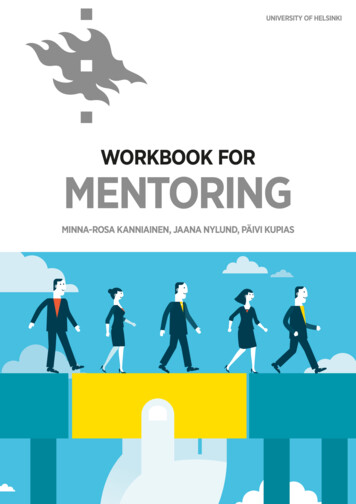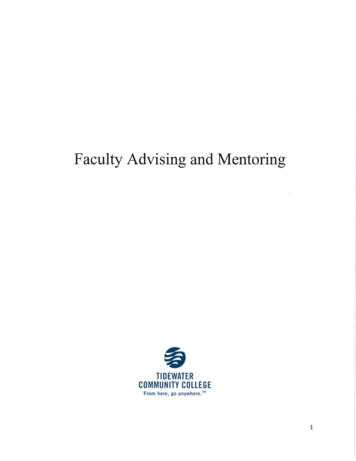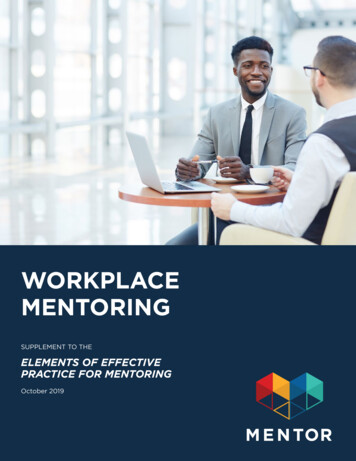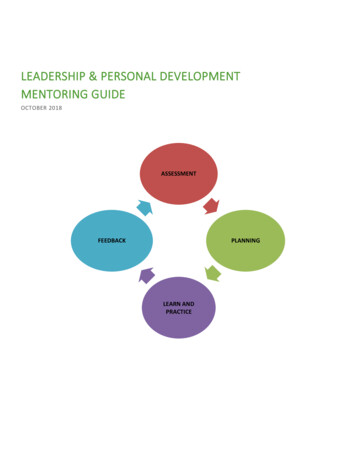
Transcription
LEADERSHIP & PERSONAL DEVELOPMENTMENTORING GUIDEOCTOBER 2018ASSESSMENTFEEDBACKPLANNINGLEARN ANDPRACTICE
TABLE OF CONTENTSINTRODUCTION . 1Section 1 – Mentoring in General . 2Coaching – Mentoring: Are these the same thing? . 2Mentoring Characteristics and Questions 4Section 2 – Who Are You?.5Strategies for Analyzing What You Need .5SELF-ASSESSMENT Tools- 5Section 3 – Action Planning . .6Ending the mentoring Relationship 11References 12APPENDIX .13GUIDANCE QUESTIONS FOR EXPLORING YOUR DEVELOPMENT .13G-STAR model .15
INTRODUCTIONWhy should we mentor?We are all working together within the Indian Health Service (IHS) to raise the physical, mental, social andspiritual health of American Indians and Alaska natives (AI/AN) to the highest level and mentoring is one ofseveral focused strategies to help develop people. As we mentor, it provides an additive impact to each of ourefforts. The more we support the development of those around us, the more effective we all are.What if I don’t have all the answers?None of us have all the answers, but as we mentor, we explore and develop ourselves as well. Your menteemay be experiencing something you have already been challenged with or it may be a new challenge.Regardless, the effort of working together to solve issues helps everyone involved develop.How do I navigate this guide?There are three sections in the guide. The first describes mentoring in general and helps you understand anoverview of mentoring including the different roles of the mentor and the mentee. The second looks atmethods of communication, analyzing what you have versus what you need, and strategies for pursuing yourpersonal development. The last section is the development of an action plan and measuring your success.Mentoring is sharing knowledge, skills and life experience to guideanother towards reaching their full potential; it’s a journey of shareddiscovery.2“One of the greatest values of mentors is the ability to see ahead what others cannot see and tohelp them navigate a course to their destination.” — JOHN C. MAXWELL
SECTION 1 – MENTORING IN GENERALCOACHING – MENTORING: ARE THESE THE SAME THING?COACHINGVS.MENTORINGTask orientedRelationship orientedShort termAlways long termPerformance drivenDevelopment drivenDoes not require designRequires a design phaseImmediate manager is a critical partnerImmediate manager is indirectly involvedCoaches are paid for their servicesMentors never receive compensation for their servicesA coach operates independentlyA mentor acts as part of a systemCoaches primarily focus on business issuesMentors balance both the business and the personalCoaching usually involves a smaller monetaryinvestmentFormal mentoring involves a larger monetaryinvestment up front, but costs less over timeCoaches leave the organization once the task isdoneMentors reside within the organization and are part ofthe company’s ongoing talent poolCoaches are mostly “outside experts”Mentors are inside expertsCoaching may include a component on how toaddress issues of diversityMentoring always involves diversity because part ofthe dialogue that takes place is the mentor and menteepersonal differencesCoaching is one-directionalMentoring is two way developmentAdapted from: Management Mentors “Coaching vs. Mentoring”As a mentor, you listen, guide, and help develop your mentee in the areas you have both identified together.One strategy may not work every time for every person and you may have opportunities to fail and try newstrategies. Those are great chances for learning, be sure and take them.Mentors should focus on: Willingness to demonstrate leadership andpeople-oriented behavior. Excellent listening, communication, andfeedback skills. Avoiding dominance, control and overprotection. Sharing knowledge of the cultureand key issues in the organization. Willingness to share personalexperiences relevant to the mentee. Able to partner, practice risk-taking, andshare credit. Demonstrating genuine interest and beingsensitive to others’ needs and developmentinterests. Committing to making time, maintainconfidentiality, and demonstrate goodwilland trust.
What experiencesand learning can Ibring to thementoringrelationship?Are there anyobstacles that couldimpede therelationship’sdevelopment?What are my ownexpectations for therelationship?What are my goalsduring thementoring process?
MENTORING CHARACTERISTICS AND QUESTIONSBenefits of MentoringRelationships Develop a network of contacts Gain insight into behaviors that support the organization’s goals and actions Be exposed to experience in other functional areas Obtain increased access to technical, administrative and organizational leaders Connect to learn from the Mentor’s experiences, personal insights, knowledge, and know-how Experience the chance to test ideas, tactics and strategies in a friendly forumWhat Research Tells Us Mentorships are the third most powerful relationship for influencing behavior Mentor must derive as much satisfaction from the relationship as the person being mentored Participant differences becomes less important as relationship develops Success requires regular contactWhat should I do as amentee? 4What are the mentoringbenefits to the mentee? 4What are the mentoringbenefits to the organization? 4Final Thoughts Understand the purpose of the mentoring relationship. Collaborate on the format of the mentoring meetings and how you work together. Communicate what you will commit to and your goals. Identify strengths and achievements Identify areas of development Increased self-confidence and motivation. Support and challenge in formulating a clear sense of personal direction. Understanding of the formal and informal culture and structures at IHS-OEHE. A source of knowledge and experience to tap into. A sounding board to discuss ideas and approaches before action is taken. An opportunity to think about things in a different way. Increased levels of motivation from those involved. Employees have a clear direction and clear objectives for their development. Improved communication at all levels and across levels. Sharing of knowledge, experiences, and best practices as a standard working model. Innovation and continuous improvement in the way employees approach their work. Identify when the relationship reaches a natural end. Conduct self-reflection and review the effectiveness of the relationship by both parties and providefeedback to each other. Set targets for future actions.Adapted from the Manchester Metropolitan University “Mentoring Guidelines”
SECTION 2 – WHO ARE YOU?STRATEGIES FOR ANALYZING WHAT YOU NEEDMany different personal assessment tools exist to better help you understandthings you do well and areas for improvement. Also, understand, over timepeople change and their personal assessment may change as well. Try tounderstand where you are in your development and what you need in the futureas you grow.SELF-ASSESSMENT TOOLS - The tools below are just a few examples of what you may take part of withinthe OEHE Leadership & Personal Development (LPD) Program.1. 360- The 360 assessment involves obtaining anonymous feedback via an online tool from you, your supervisor,peers, and people you supervise.2. Myers Briggs Type Indicator- The Myers-Briggs Type Indicator (MBTI ) Step I is based on Carl Jung's theory ofpsychological type. It indicates your personality preferences in four dimensions: Where you focus your attention– Extraversion (E) or Introversion (I) The way you take in information – Sensing (S) or Intuition (N).3. DISC- The DiSC profile, published by Wiley, is a non-judgmental tool used for discussion of people's behavioraldifferences. The four personality types are Dominance, Influence, Conscientiousness, and Steadiness4. Leadership Competency Assessment (LCA) - The LCA illustrates strengths and growth areas on specific LPDcompetencies and the behaviors within by collecting anonymous feedback via an online tool from you, yoursupervisor, peers, and people you supervise.5. SWOT- SWOT stands for-strengths, weaknesses, opportunities and threats. This analysis is a framework foridentifying and analyzing the internal and external factors that can have an impact on the viability of a project,product, place or person.Should I take a personal self-assessment?Where are you in your career?Are your mentoring needs specific or broad?These questions should be explored with your mentor and determinetogether, the best method for your development.The following pages will help you develop an action plan to addressyour needs related to maintaining your strengths and addressingyour growth areas.
SECTION 3 – ACTION PLANNINGWe are voluntarily entering into a mentoring relationship so both we and the IHS may expect to benefit. Theconversations we have and development plan are confidential and we will agree to this mentorship contract durationof:Mentor SignatureDateMentee SignatureDateAction plans can be very detailed or general depending on the issue(s) to be addressed and the underlyingreasons for those issue(s). As a beginning, complete the section below together to develop your logistics.How often will we meet?When will we meet?Where will we meet?How long will it last?Who will schedule meetings?How will meetings be scheduled?STRATEGIES TO REMEMBER Get to know each other. Talk about your work and your life outside of work. The mentor shouldtry to understand what the mentee thinks and why. Value their viewpoint.Do what you say you are going to do. Agree what you are aiming to achieve through yourmentoring sessions. Be reliable and always do what you say you are going to do.Communicate openly and honestly. Discuss issues as soon as they arise. Ask for and givefeedback.Don’t be afraid to challenge. Your open, honest relationship will allow you to challenge yourmentee constructively to explore a wider viewpoint.“Trust is the highest form of human motivation. It brings out the very best in people.” Stephen Covey(Management Development Consultant)
ACTIVE LISTENINGThe mentor will be engaged in active listening. Implement good questioning techniques and then recap,paraphrase, and summarize to try and get to the center issue being raised. Remember you are there to guidethe mentee, not to provide a solution or impose your point of view. Stop Talking Don’t judge Be patient Be yourself Demonstrate listening Respond to feelings but not by ’intellectualizing’ Resist the temptation to interrupt with a ‘solution’ Focus on the speaker whether in person or on the phone Only offer solutions/alternative once the speaker is done talking or starts to become repetitiveYour Mentoring History, Carried ForwardAs you mentor, consider what lessons you have learned throughout your career and whatwould be helpful to pass on to others.1. List 2-3 critical conversations or events that occurred in the course of your career. List theexperience, how it occurred and what affect it had on you.2. Who provided you a quote that had great meaning for you? Pick on that influenced yourthinking or behavior and that you sometimes repeat. Write down once such quote andwhere it came from.3. Who helped you uncover an aspect of an ability or talent that, until then, had beendormant? Describe one such incident.4. Summarize the characteristics of people who provided the most valuable learning to youover the years.
GOALS & EXPECTATIONSAs you discuss what each person wants to accomplish, be sure to acknowledge & understand differences incommunication between men and women.Also, understand your communication style and how it interacts with the other person. It may be helpful tostart your discussion by sharing how you best communicate.To explore goals, focus on: Particular issues the mentee encounters Their achievements so far and how to build on themRealistic expectationsA scale of prioritiesAreas in which they would find input most usefulWhat are the 1-3 specific learning goals you want to achieve?What does the mentor need to provide to assist the mentee?
SELF-DEVELOPMENT TARGETSHaving worked through some initial conversation, the likelihood is some ‘new understanding’ will be reachedabout the goal(s) being discussed. Regardless of the size or significance of the goals, your role as the mentor isto reflect back to the mentee what they have expressed. You should then guide the mentee through thinkingabout potential actions as outlined below to achieve their goals.GUIDANCE QUESTIONS - For more examples, please refer to the Appendix1. In your view, what are 2-3 skills, insights or information that would help you better perform your currentassignment?2. Think of areas that you, your manager, peers or others think you need to increase knowledge or develop.3. Consider past performance reviews or feedback you’ve been given. What growth areas have beenpresented to you?4. If there is one thing you could select to gain from a mentoring relationship, what is it?
You have developed goals, and explored some guidance questions on the previous page, or in the appendix.Now, list some areas you feel are important to develop in yourself to achieve your stated goals.1.2.3.What are reasonable timeframes to accomplish these actions?1.2.3.IMPLEMENTATION AND EVALUATIONOnce the mentee determines the actions to be taken and when, you must ensure these are recorded and thenmonitored through regular review and feedback. Again this is not about you as the mentor telling the menteewhat to do. You serve as a guide to the mentee towards identifying and implementing actions.
RECOVERING FROM MISTAKESEveryone makes mistakes andsometimes, they can result insomething great.Here are five strategies to practice tohelp you recover from your mistakes. Own itGood Mistakes: Chocolate Chip Cookies, Post-it Notes, X-Rays Sometimes, when we make mistakes, we focus too much on the negative (negativity bias) and have difficultyobserving what we have done well. View your error(s) honestly and objectively to determine yourcontribution to what went wrong. Owning your mistake is not criticizing your self-worth. You are accepting responsibility for your actions andat the same time, realizing mistakes are normal and no one is perfect. Having a growth mind set will help you advance. Having a fixed mind-set where you think things won’t everchange, will ensure the mistake is repeated. Our world is constantly changing and evolving. If we don’tchange and evolve with it, we won’t improve and continue to be effective. Apologize We are our own worst critic and we need to tell ourselves we aren’t perfect and won’t alwaysrise to our self-defined expectations. If someone else was involved in the result of yourmistake, apologize to them and move on, it will help them feel respected and will ensure youaren’t carrying a burden unnecessarily. Accept consequences We have all heard the cliché, “You made your bed, now lay in it.” Confronting our ego andthe image we want to exemplify can be difficult. Effective leaders are humble, honest,accountable, and many other things. When we try to avoid the consequences of our mistakes,it oftentimes makes things worse. Dealing with the consequences will help you remember themistake and reduce the likelihood of repeating it in the future.
Learn from it Make your mistake work for you. Connect your feelings related to the mistake you experience and you willbe less likely to commit the same mistake again in the same situation in the future. In the 2017 study“Emotions Know Best: The Advantage of Emotional versus Cognitive Responses to Failure” (Nelson, Malkoc,Shiv), the authors provide research pointing to the importance of learning from your mistakes byemotionally experiencing them rather than just thinking about them. The study identified that emotionallyexperienced failure better motivates increased effort and may reflect the persons desire to improve. Let it go One University of California, Berkeley, study published (2013) found when a group of students failed a test,those who were reminded to be self-compassionate (with phrases like "Try not to be too hard on yourself"or "It's common for students to have difficulty with tests like these") were motivated to spend more timestudying for the next exam, compared with students who were given statements meant to simply boosttheir self-esteem ("You must be intelligent if you got into Berkeley!"). "We found that people who weretaught to be kind to themselves felt more motivated to see their mistakes as a chance for growth," sayslead researcher Juliana Breines, PhD. "Outside validation didn't seem to matter as much." Don’t hold yourself hostage by your mistakes. Dwelling on your mistakes takes energy away from what youdo well. The longer amount of time you wait to address your mistakes, the more difficult it will be to getback on track.Own ItAccept ConsequencesMistakesApologizeLearn From ItLet It GoImprovement
ENDING THE MENTORING RELATIONSHIPThere will come a time when the mentoring relationship will begin to draw to an end. At this point you mustboth ‘let go’ so that your mentee can maintain their independence. It will then become their responsibility toput what they have learned into practice. Although the two of you will probably continue to have some formof interaction, it should be on a more casual basis, where you consider each other as equals.To help you end your mentoring relationship successfully: Celebrate your success. Have a look at the goals you set when you first met. Consider what you haveboth achieved during the process and reflect on what you can take to your next mentoring relationship. Say goodbye. End the session on a positive note. You could talk about what you most enjoyed, whatyou’ll remember most or the most important things you’ve both learned.Meeting Logistics:
REFERENCES1. Strategy works: https://www.strategyworksinc.com/2. -is-mentoring3. Management Mentors “Coaching vs. Mentoring 25 ways they’re different”4. Manchester Metropolitan University “Mentoring Guidelines”5. ing-mentoring-differences6. -is-mentoring7. ople-recover-after-making-a-mistake.html
APPENDIXGUIDANCE QUESTIONS FOR EXPLORING YOUR DEVELOPMENTPERSONAL1.Think about your last few performance discussions with your supervisor or a discussion you had with colleaguesabout your job performance. List any insights you may have gained about particular areas of strength you bringto your current position.Circle three (3) items below that match your preferences for how you most enjoy working:a.b.c.d.e.f.g.h.i.j.Outdoors, outside of an office settingWith close proximity and involvement with other peopleBy myself but having close proximity to othersBy myself, seldom having people interactionIndependently, with minimal supervisionIndependently, with close connection to my supervisorPerforming tasks solely in teamsWhen there is a good balance between working alone and with othersWorking aloneWorking indoors in an office settingGiven your responses to the above questions, what key insights do you have about your personal preferences?2. Are there skills and abilities you think you possess but are not using? If so, what are they?3. Do you have any other insights about your current work and some personal changes you can make to becomemore effective?CAREER1. List three (3) aspects of your current assignment that you particularly enjoy.a.b.c.2. List three required tasks or aspects of your current assignment that you either do not enjoy doing or for whichyou are not appropriately skilled or trained.a.b.c.3. Where do you want to be in a year? Two years?
4. What areas of work do you find most satisfying?5. When asked about the work you do today, what adjectives do you typically use to describe your current job?6. What aspects of your performance could you focus on to improve?7. Think back to the time you were deciding whether or not to accept your current position. What attracted you tothat job or profession?8. Are there skills and abilities you think you possess but are not using? If so, what are they?9. Are there any areas of work or a position you would pursue if you had the skill? If so, what are they?10. Do you have any other insights about your current assignment or areas you may pursue or change as they relateto your career development?
G-STAR MODELThis is a particularly useful technique in mentoring. Use it to ask your mentee about a particular issue – it can oftenbe a fast track to the real answers your mentee is looking for.G – What are your mentee’s GOALS? What are your goals for today’s discussion? What will give you the most value from today’s session? Do you have control over this issue? When do you need to achieve this goal by?S – What SITUATION is your mentee facing? How do you feel about the situation? How can you describe the situation? What do you know about the current situation? What do you not know about the current situation?T – What is their THINKING at this time? What options have you considered about the situation? What underlying assumptions are you making? Think how others would solve this problem. Think about how you will measure your success.A – What ACTIONS are they considering? What do you need to do first? By when do you need to have this done? In what sequence will you do these tasks? Can you think of anything that may disrupt your actions?R – What RESULTS do they expect? Are the results realistic? Have you considered other outcomes? What contingencies can you put in place? What are the consequences of not achieving these results?
4. Leadership Competency Assessment (LCA) - The LCA illustrates strengths and growth areas on specific LPD competencies and the behaviors within by collecting anonymous feedback via an online tool from you, your supervisor, peers, and people you supervise. 5. SWOT - SWOT stands for-strengths, weaknesses, opportunities and threats.
